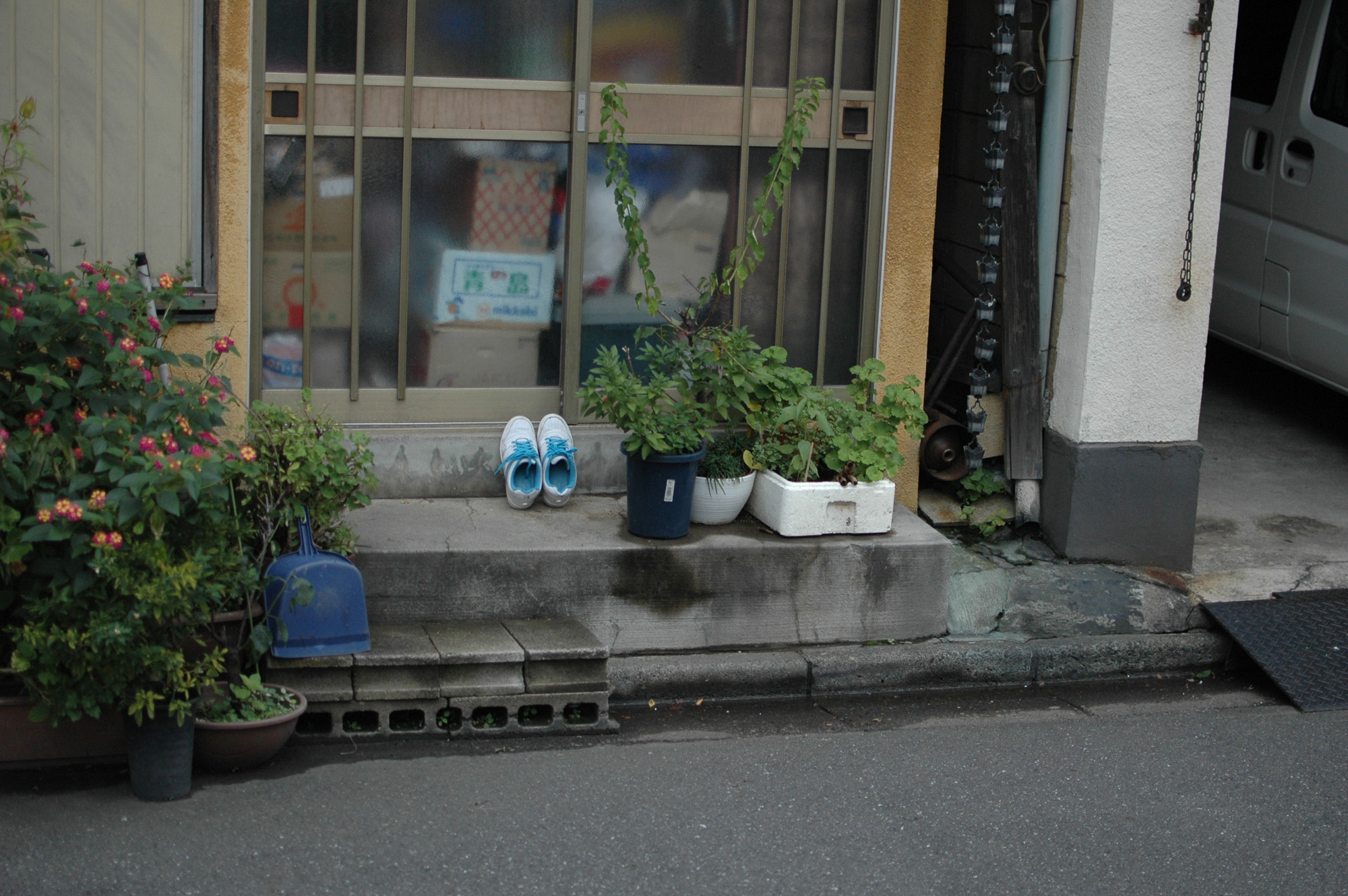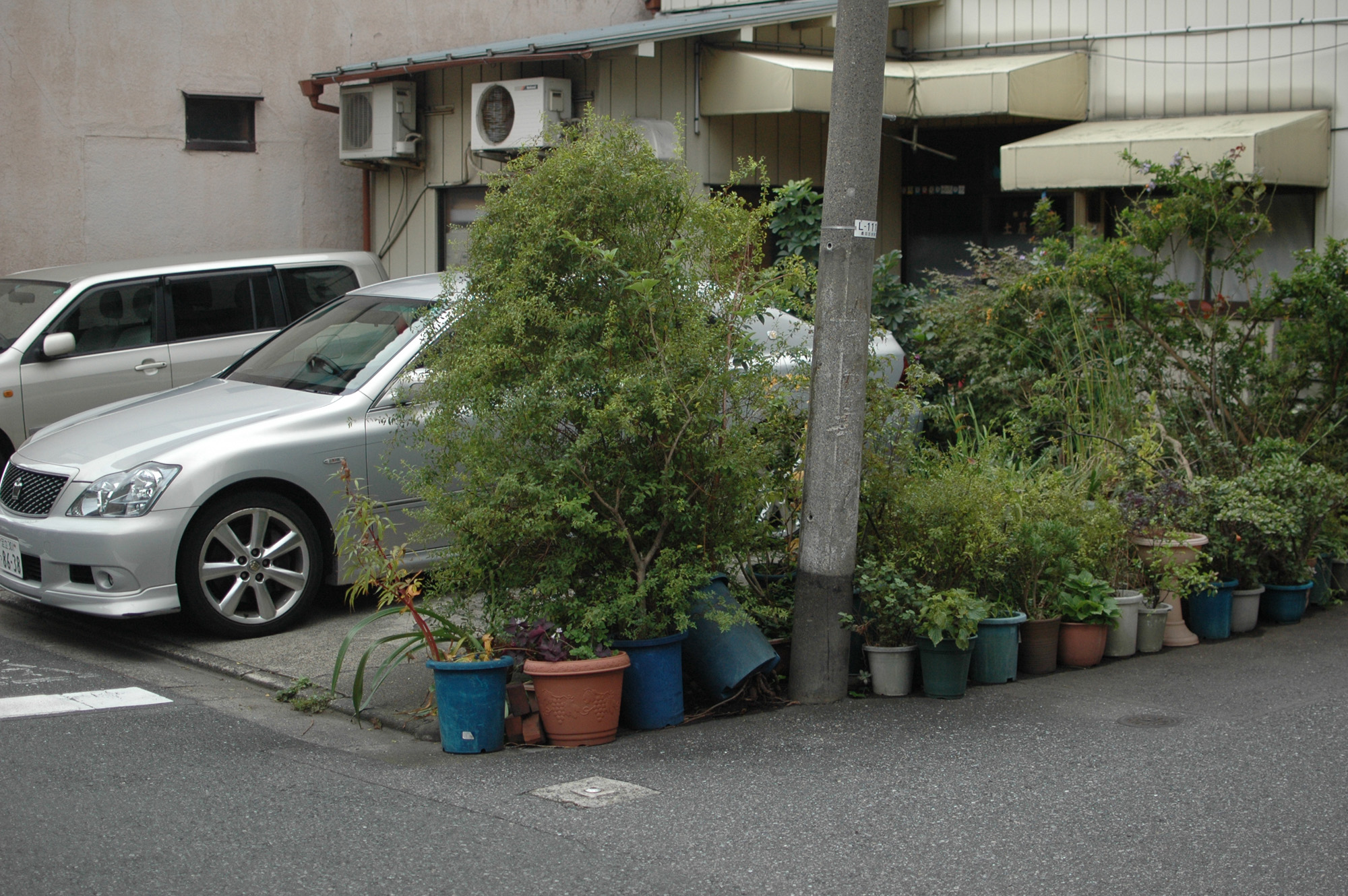The Edge of the Forest in the Center of the City
In the old part of the low city of Tokyo, on the flat planes east of Sumida River, lies Higashi Komagata. Higashi Komagata is an old worker district of Tokyo developed during early Edo. Across the water lies bustling Asakusa, crowded with tourists, shops and entertainment, all built around the historic temple grounds that are prominent in every Tokyo travel guide. A little to the north of Higashi Komagata is the Tokyo Skytree: Tokyo’s enormous broadcasting tower and favourite spot to look at the city from above. With these crowd pleasers in its vicinity, Higashi Komagata is a notably quieter place. The neighbourhood is mainly residential, with a couple of companies, such as a car repair shop and some indistinct garages. The neighbourhood is quite generic, with its indistinct buildings and straight grid pattern.
Higashi is one of over a thousand Greater Tokyo neighbourhoods. What does it mean to be so far from nature, in an endless city?
“One plant has outgrown its pot completely and grown into a flowering bush.”
There is one intersection in Higashi that is home to some very enthusiastic gardeners. One of the houses is completely lined with plants, three rows wide, some growing as tall as the first floor. The plants are close to the house, and hanging from the façade. The home across has a small private yard with a few small potted plants. But the majority of the garden is outside the plot, lining the fence on the west side and façade on the south side. The pots are placed on small pedestals. One plant has outgrown its pot completely and grown into a flowering bush. Bordering the façade the garden is again three rows strong, but not as tall and neatly maintained as its neighbour.
Green space in Tokyo is close to home, meticulously taken care of, and representative of something that is absent in a metropolis: nature. There are more ‘semi-private’ informal gardens than there is public greenery in the city. It is interesting to see how these gardens are situated in transitory areas. They are privately owned but anyone can enjoy them. The gardens connect the notion of home and belonging, to the notion of nature.
In the way Japanese think about both home and nature there is one concept that is most important: the uchi versus soto duality. These terms meaning inside and outside, are used in creating a sense of self. The stress is on us (uchi) versus others (soto), and less so about the individual versus the rest of the world. Uchi connotes not the individual, but the closest group around the individual, the community. The key inside (uchi) group is the family. (Daniels, The Japanese House, 75) The word uchi is also transferred to broader groups, like neighbours, schoolmates, colleagues, and even national subjects. Apart from the societal meaning of the word uchi, it also signifies the home itself. In the house you find physical markers of the uchi-soto dichotomy. The concepts show in the shape of boundaries to regulate the distinction between the two, and prescribe social rituals and the organization of space. (Ronald, Home and Family in Japan: Continuity and Transformation, 175-176) Traditional Japanese architecture consists of transitory unit, where every unit serves a bridge between the foreground and the deeper interior. (Ronald, Home and Family in Japan: Continuity and Transformation, 177)
The most obvious example is the genkan. The genkan is an entrance vestibule, the first space you enter when you step through the front door. When you enter a Japanese home it is expected you take of your shoes. The genkan is a spatial translation of the ritual of making sure dirt is not transported from outside to inside.
In the traditional house (during Tokugawa) the largest part of the house was reserved for entertaining. The male household entertained the guests with a view of the garden. The garden functioned as a decor piece. The uchi at this time seems to have a less private character than later on (during Meiji), when the focus was on the smallest possible uchi with the conjugal family. During Meiji the home was redefined as an intimate space set apart from society and focused on parents and children. The Japanese family, and with it the home, became more private.
Recently developers have started catering to the single working man and woman as well. It is uncommon in Japan to live with non-family. The idea of a share house is gaining ground, but still thought of as strange. This means that there are a lot of very small individual homes in Tokyo. This individualization of space leads to an increasing sensitivity of privacy. (Ronald, Home and Family in Japan: Continuity and Transformation,, 190) With the continuing fragmentation of plots due to the inheritance taxes on ground and the building setback regulation that allows building on 100% of a plot neighborhoods are very dense with barely any open space. (Jonas, Private use of public open space in Tokyo)
The small homes and apartments are supported by Tokyo’s impeccable infrastructure. Here the konbini (convenience store) plays the star role. In the konbini you can do everything you would normally do in your living room or study. You can make a copy, get money, pay your bills, buy underwear, get food. With a documentation system in place in every konbini, it caters perfectly to the urban dwellers around it. (fig. 3.9)
Uchi seems to have turned out to be both more private, as the home is only used by its inhabitant, but at the same time more public as well, as many functions that traditionally took place inside the safe realm of the home have now been moved outside, into the street and konbini. Social activities with friends or family take place outside of the home, in public spaces. The neighbourhood can be described as more uchi then soto. The garden traditionally is part of uchi. The potted gardens can also be seen as an extension of the uchi into the soto of the street.
“The high city ... knew vast garden settings unimaginable in a western city. ”
On the main road in Higashi Komagata one home has plants in and outside of a small garage. The plants are piled inside, as if they’re waiting for a good spot outside.
To be able to use the street in such a manner, the urban fabric has to support it. The foundation for this informal space in Tokyo streets lies in Edo. During Tokugawa (1600-1868) Edo (now Tokyo) was the home of the shogun, the de facto ruler of Japan. The city was divided into two parts: high and low.
The high city was a lush garden city home to the rulers of Japan. These areas knew vast garden settings unimaginable in a western city. The upper class retreated and worked in their grand garden residences in natural solitude, in the urban centre of Japan. It is argued that this attitude continues to inform the sensibilities of present day Japanese, who aspire to live in an independent house with a garden, however cramped it might be.(Jinnai, Tokyo: A Social Geography, 14-29)
The low city was a completely different place. Edo’s low city was home to the commoners (machichi) of the Tokugawa era. It consisted of bustling districts with all kinds of different trades. The area knew high population densities. Houses were built close together, one storey high. In the middle of each block there was an open space used for stalling garbage, for cleaning, and other domestic activities. As Edo grew the open spaces were often filled in as well, leaving only small alleys to reach houses in the middle of a block. (Sorensen, The making of urban Japan, 27-30) These alleyways were the stages for public life in Edo. The backstreet was all the open space they had in these densely populated areas, as the houses had no backyards. They became the place to keep potted plants, to let children play, to make a fire to cook on, and they also functioned as a common toilet as well. (fig. 2.14) (Jinnai, Tokyo: A Social Geography, 62)
This traditional urban fabric was enforced with the implementation of the egg and shell pattern in modern urban planning. This entails that low-rise residential areas (eggs) are surrounded by a shell of high-rise buildings facing the larger streets on the edge of the chome (shells). In Higashi as well the taller buildings are situated on the larger streets. From multiple streets you have a view of Tokyo Skytree, and the high-rise buildings on the bank of Sumida River. These larger buildings protect the residential area from traffic and noise. (Jonas, Private use of public open space in Tokyo) This way Tokyo is, despite the more than 3 million cars registered in the city, a city of pedestrians. In the security offered by the egg and shell pattern autonomous neighborhoods have a chance to bloom. They seem to form an indestructible fabric among the expressways and high-rises, where small streets are lined with bicycles, potted gardens and unsupervised umbrellas. In one of Higashi’s smaller streets one homeowner keeps seedlings outside the house on the street. They’re lined on the edge of the road in rectangular containers. It looks like a public nursery.
However, in Higashi Komagata the typical low city atmosphere is less present. In more modern looking, less charming neighbourhoods (such as Higashi Komagata) gardens are equally omnipresent. To an outsider the street feels like soto, but it wouldn’t come as a surprise if these neighbourhoods still have the potential to be classified as uchi. It is merely less obvious, but all the ingredients are there: neighbourhood noticeboards, a local shop, a feeling of safety, etc. This can be seen as a proof that the street gardens have spread out over the city, escaping their roots that lie in the small and contained low city streets.
The concept of uchi and soto is not only used in the discourse on home and street, but is also a key notion to understanding the Japanese relationship with nature. Both Japanese and western scholarly and popular discourse suggests a unique Japanese way of relating to nature and consideration of Japanese culture as nature-loving. According to this discourse the Japanese live in harmony with nature, have a profound love for it and a great appreciation of natural beauty. This is a commonly held view that has been developed and repeated for centuries. (Kalland and Asquith, Japanese Images of Nature, 1-2) This idea exists because images of nature have played a central role in the construction of nationhood in Japan. Representations of nature played a large part in shaping the Japanese nation and the Japanese self during Meiji (1868-1912) when orientalist imagery was re-appropriated: characteristics that were meant to suggest the weakness of Eastern people were redefined as strengths. Asian culture was deemed superior to western culture spiritually, artistically and morally. Westerners had supposedly become alienated from nature, whereas the Japanese had stayed true to their close relation with it. The love of nature is presented as the nature of the Japanese. (Rots, Forests of the Gods, 104-106) Artistic and literary expressions were proof of this typically Japanese closeness to nature. For example a text by Anesaki: ‘In many countries nature is thought of as necessarily wild and bold, in contrast to human refinement. According to that conception, life consists in the combat against nature, or in the conquest of it. But the Japanese lives too close to nature to antagonize her, the benignant mother of mankind. Just as art has permeated every corner of life in Japan, so Japanese art always derives its model and inspiration from nature. … Benignant friendliness is the most striking feature of land and atmosphere in the Japanese archipelago.’ (Anesaki, Art, Life and Nature in Japan, 6-8) It is important to note that when this work was written Japan had just invaded Manchuria, and Meiji-period industrialization had already resulted in large-scale environmental pollution, raising questions about the meaning of this alleged love of nature. (Rots, Forests of the Gods, 104-111)
The type of nature the Japanese enjoy can explain this discrepancy between the love of nature and the simultaneous environmental destruction. Japanese like ‘to go to the edge of the forest, to view nature from across the river, to see natural beauty from a mountaintop, but rarely to enter into or immerse oneself in wildness or the ecological understanding of natural settings.’ (Kellert, The Value of Life: Biological Diversity And Human Society) It’s not so much the sublime and large nature that tickles their fancy. Instead, the Japanese incorporate nature into their culture. Nature is brought into everyday life, in advertising, popular culture, art, etc. The wilderness ‘out there’ is a far cry from this type of nature and very different from it. The concept of nature in Japan is much broader than it is in the West, as it is oscillating between two extremes: raw and cooked (or soto and uchi) ‘Contextualization allows for multiple concepts of nature to exist: wild and threatening, or in its most cultivated form with a garden, a dwarfed tree, or a softdrink in a vending machine.’ (Kalland and Asquith, Japanese Images of Nature, 15). The love of nature was and is mostly practiced close to home, in the safe realm of the uchi. This is the way in which Japanese deal with nature: they appreciate it most in confined, safe, representations. ‘Japanese pull with their metaphorical rope mountains and sea into their tiny gardens and further into their houses.’ (O-Young Lee in Kalland and Asquith, Japanese Images of Nature, 16)
An appropriation or translation of nature in the shape of a bonsai, ikebana, an image, flavors or rituals is still nature. Something artificial can also be seen as nature. Nature is symbolic rather than realistic.
Many gardens in Higashi feature memorabilia from vacations, such as rocks or cans used as planters, and plants and seeds that the owner brought back from a trip to another part of the country. But also walks closer to home are a source of the plants in the gardens. The garden can be considered a place of collected meaning and memory. In this respect the street gardens play a part in the Mythic Field, an important factor in feeling at home in the city. The theory of the Mythic Field claims the structure of Tokyo is not to be found in its physical form, but in another layer, ‘imperceptible but powerful’, which defines the city. This layer is based on symbolic meaning: ‘a mythic field, providing coherence to a fractured and ever changing urban landscape.’ The elements that make up this layer are symbolic: traditions and rituals, local foods, signs of konbini’s and shops, the omnipresent vending machines. The potted plants are an example of this concept, just as the daily care of the gardens. Other examples are the changing of the seasons and the distant mountains that were once visible from the city now mainly present as symbols in the mind of the Tokyoites. Communal identity is not formed by buildings or urbanism, and instead monumentality is to be found in dynamic processes, forming a symbolic layer covering the city. This mythic field reinforces the identity of the Tokyoites as people categorize themselves and their surroundings based on it, ‘and it is this layer that makes Japanese space undeniably Japanese.’ (Berkhout, Mythic Field)
Edo was developed in relation to grand natural surroundings. Mount Fuji and Tsukuba, looming far in the distance, maintained a great presence in the city dwellers’ consciousness both as geographical orientations and as repositories of symbolic meaning. The Japanese regarded and worshipped their mountains as the enshrined spirits of gods. (Jinnai, Tokyo: A Social Geography, 122) Tokyo used to have a number of ingenious mechanisms built into its urban environment that made possible a dialogue between human beings and the spaces they inhabit. The high city knew many panoramas. (Jinnai, Tokyo: A Social Geography, 56) This grand scale has disappeared from Tokyo but the small scale stayed and provides the stage for the street gardens. This is the setting for the different modes of uchi in Japanese society that the potted plants are part of. The well-kept miniature gardens embody exactly what nature means in Japan.





